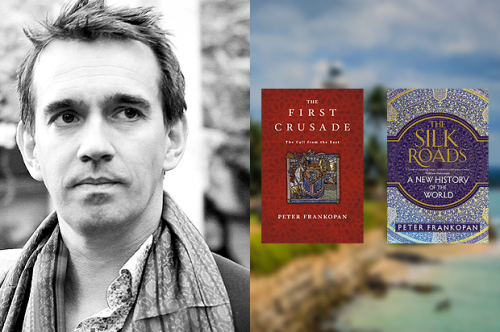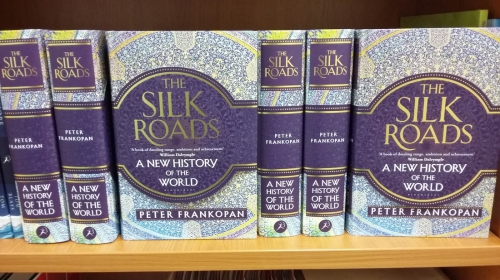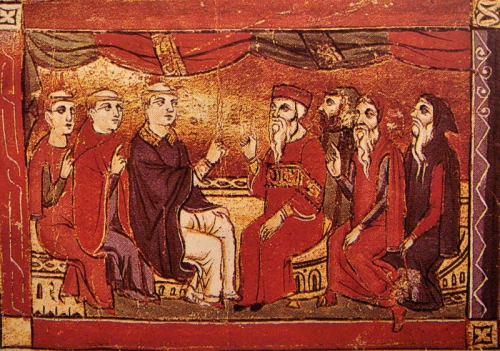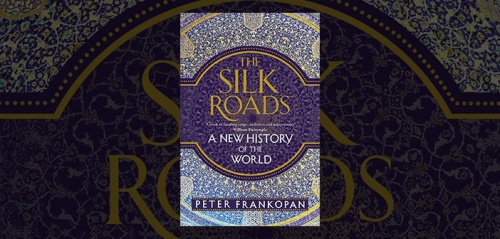Frankopan begins his journey not with trade in goods but trade in faith. Buddhism, Hinduism, Jainism, Manichaeism, Zoroastrianism, Judaism, Christianity (of more than one flavor), and eventually Islam (of more than one flavor) all come into play in this journey, and not always in a peaceful way.
As early as the third century B.C, Buddhist principles could be found as far to the east as Syria, with a Jewish sect in Alexandria, Egypt known as Therapeutai bearing unmistakable similarities to Buddhism. In central Asia, forty Buddhist monasteries ringed Kabul. Noted a visitor:
“The pavement was made of onyx, the walls of pure marble; the door was made from moulded gold, while the floor was solid silver; stars were represented everywhere one looked…in the hallway, there was a golden idol as beautiful as the moon, seated on a magnificent bejeweled throne.”
The first four centuries of the first millennium saw the explosion of Christianity and “a maelstrom of faith wars.” Persia, the leading power during the rise of the Sasanian dynasty, was Zoroastrian, persecuting other religions and sects.
The story of the spread of Christianity from Palestine to the west is well known; the spread of Christianity to the east was far more remarkable and extensive. Christianity was brought in through the trade routes, as well as through the deportations of Christians from Syria. It was a Christianity with a communion different than that to be found in Rome. This difference would prove to play a key role in the not too distant future.

Evangelists reached north into Georgia, reaching a large community of Jews who converted. There were dozens of Christian communities along the Persian Gulf and as far to the east as today’s Afghanistan. As the influence of Christianity increased, the persecution by the Zoroastrian Persians followed suit. For the leaders of the non-Persian minorities, Christianity was seen as a way to break free of the empire. It was seen this way by the Persians as well.
Precisely how and when rulers in the Caucasus adopted Christianity is not clear. One example regarding this should suffice, regarding the conversion of the Armenian King Tiridates III at the start of the fourth century:
…according to tradition, Tiridates converted after turning into a pig and roaming naked in the fields before being healed by St. Gregory, who had been thrown into a snake infested pit for refusing to worship an Armenian goddess. Gregory healed Tiridates by causing his snout, tusks and skin to fall off before baptizing the grateful monarch in the Euphrates.
Way better than the story of Constantine, who looked up in the sky and saw a cross-shaped light.
Constantine’s conversion was a blessing to Christians of the west; it led to a disaster for Christians in the east. While Christianity was not made a state religion, Constantine did declare himself the protector of Christians wherever they lived – even outside of the Roman Empire.
To the Persians, he presented himself as speaking on behalf of these eastern Christians. From here on, every conversion was seen as an act of war. In order to protect these eastern Christians, Constantine planned his attack on Persia; he was going to bring about God’s kingdom on earth. As noted Aphrahat, head of a key monastery near Mosul, “Goodness has come to the people of God…the beast will be killed at its preordained time.”
Apparently this wasn’t the preordained time. Unfortunately for these Christians, Constantine fell ill and died; Shapur II proceeded to unleash hell on the local Christian populations as payback for Constantine’s aggressions. The list of martyrs was long. It truly was a disaster for Christianity in the east.
Eventually the conflicts between Rome and the Persians settled down; the Persians secured key points on the routes of trade and communication. Half of Armenia was annexed. Both powers were faced with a new enemy coming from the steppes of Asia.

Driven by famine attributed by the author to catastrophic climate change (too many cows? Volkswagen diesels?), the tribes of the steppes were driven westward. They drove refugees in front of them, clear to the Danube. Persia was not spared this invasion, with attacks along the major cities of the Tigris and Euphrates rivers. This drove Persia and Rome into a previously unlikely alliance.
A massive fortification was built by the Persians along a 125 mile stretch between the Caspian and Black Seas. Thirty forts spanned this expanse; a canal fifteen feet deep protected the wall; 30,000 troops manned this barrier. Rome made regular financial contributions in support of this fortification; further, they supplied a regular contingent of soldiers to defend it.
As far as Rome itself was concerned, it all came too late; in 410, the city was sacked. The city that controlled the Sea which was considered to be the center of the world was conquered. To the Christian men of Rome, this was God handing out punishment for man’s sinful ways; to others, it was a result of Rome’s turn to Christianity and away from its pagan roots.
This was a benefit to Christians in the east; Rome was no longer seen as a threat to Persia. Constantinople had its own defenses from these hordes to worry about, so there was little threat from this quarter either.
This relative calm allowed for the various Christian sects, east and west, to work out the doctrine – turning the Gospels and letters into consistent practice, belief, action and governance; the perfect opportunity to turn Christianity into a unified church.
It didn’t work out this way. Bishops against bishops, sects against sects, unsettled debates at the various councils, power politics, and excommunication freely offered. To offer any meaningful detail would only make my head hurt.
While the church in the west was busy rooting out deviant views, the church in the east went on a missionary outreach to rival any other. From the tip of Yemen to Sri Lanka, Christian communities could be found headed by clergy appointed from Persia. The author suggests that even during the Middle Ages there were more Christians in Asia than in Europe.

This outreach was made possible due to the tolerance shown by the Sasanian rulers of Persia – you might consider these the Constantines of the east. The clergy would pray for the Shah’s health; the Shah would organize elections for the clergy.
It might be generally said that religious tolerance was shown throughout the region. In Bamiyan, within today’s Afghanistan, two immense statues of Buddha stood – one as high as 180 feet. Carved in the fifth century, they were left intact under later Muslim rule for 1200 years, ending only under the Taliban in 2001.
Others did not show as much tolerance. While the Palestinian Talmud refers lightly to Jesus and His followers, the Babylonian Talmud takes a “violent and scathing position on Christianity.” Converts to Judaism, according to one prominent rabbi, still had the evil in them until twenty-four generations have passed.
In the kingdom of Himyar, in the southwestern corner of the Arabian Peninsula, Jewish communities became increasingly prominent. Judaism was adopted as the state religion; Christians faced martyrdom for their beliefs, after being condemned by a council of rabbis.
In any case, by around the middle of the seventh century, Christianity was generally on the march east, at the expense of Zoroastrianism, Judaism and Buddhism.
This period was to quickly come to an end.
Reprinted with permission from Bionic Mosquito.




 del.icio.us
del.icio.us
 Digg
Digg
 The very mention of the Silk Roads creates an instant image: camel caravans trudging through the high plains and deserts of central Asia, carrying silks, spices and philosophies to Europe and the larger Mediterranean. And while these ancient routes may remain embedded in our imagination, they have, over the past few centuries, slowly faded in
The very mention of the Silk Roads creates an instant image: camel caravans trudging through the high plains and deserts of central Asia, carrying silks, spices and philosophies to Europe and the larger Mediterranean. And while these ancient routes may remain embedded in our imagination, they have, over the past few centuries, slowly faded in